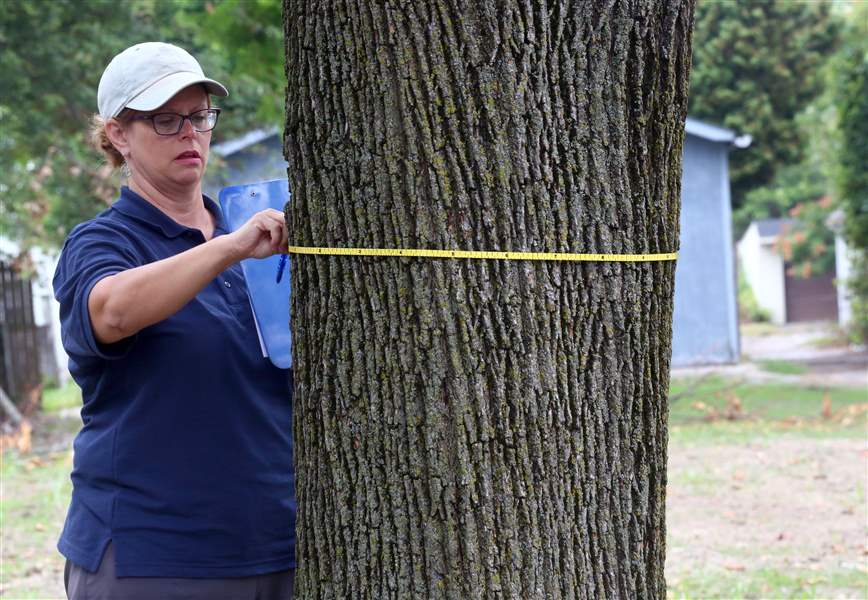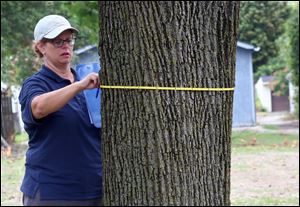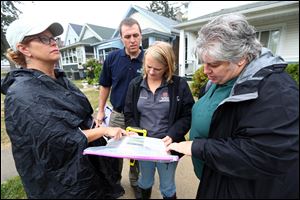
Five-decade tree study continues in Toledo
8/28/2017
Stephanie Miller, urban forester at ODNR Forestry, measures the diameter of a tree at the 1123 Noble St., location for the project called the Street Tree Evaluation Project, an inventory on the health, species and diversity of city trees. It began 50 years ago and is done in Toledo and other cities such as Cleveland, Cincinnati, Columbus, and Wooster.
The Blade/Amy E. Voigt
Buy This Image
Data was collected in Toledo again Monday for a little-known tree study that has been done in five Ohio cities the past 50 years.
Called the Street Tree Evaluation Project, the ongoing study generates information every decade about the health and growth of city trees in Toledo, Columbus, Cincinnati, Cleveland, and Wooster.
In each city, select residences have been part of the study since it began in 1967. Once every 10 years, officials from the Ohio Department of Natural Resources’ Division of Forestry and Ohio State University Extension revisit the neighborhoods to assess trees in the middle and to the left and right of chosen addresses.

Stephanie Miller, urban forester at ODNR Forestry, measures the diameter of a tree at the 1123 Noble St., location for the project called the Street Tree Evaluation Project, an inventory on the health, species and diversity of city trees. It began 50 years ago and is done in Toledo and other cities such as Cleveland, Cincinnati, Columbus, and Wooster.
They measure diameter, height, and canopy while also making visual observations about how, if at all, neighborhoods have changed. They also take photographs and make general observations about tree health.
In Toledo, data was collected from 11 sites within city limits. Through the study, researchers can show local officials how the same trees in those selected neighborhoods have grown and changed each decade.
A street with large, healthy trees “brings a community together” in simple ways, such as encouraging people to come out on their porches more often to enjoy shade and converse, Tyler Stevenson, Ohio DNR urban forestry program manager, said.
Stephanie Miller, Ohio DNR regional urban forester, said studies show large, healthy shade trees improve property values, reduce air pollution, lower crime rates, and even help people become healthier by making walks more comfortable.
The idea is to remind cities such as Toledo that trees are good investments, she said.
“You need to plant the largest tree that’s going to fit on the site,” Ms. Miller said.

From left: Stephanie Miller, urban forester at ODNR Forestry, Tyler Stevenson, urban forestry program manager at ODNR, Amy Stone, extension educator at Ohio State University Extension, and Kathy Smith, program director, forestry, OSU, look at the pictures to try to identify the trees for their study on 1121 Camden St. The trees no longer existed to collect the data so the site was "retired."
Those two were among four people gathering data. Their overall impression was not much has changed over the past decade among the 11 sites that are still part of the study.
But Amy Stone, OSU Extension educator for Lucas County, noted fewer than half of original sites are still be studied. Many had to be “retired” after the last survey in 2007 because of their heavy reliance on ash trees, she said.
Nearly all of the millions of ash trees in Ohio were killed by, or had to be taken down in response to, damage from the highly destructive invasive beetle from Asia known as the emerald ash borer.
The pest was accidentally exported from China to a Detroit suburb via shipping crates in 2002. It spread across northwest Ohio like wildfire in 2004. It has since obliterated billions of ash trees across North America, making it one of the continent’s most devastating experiences with a tree pest.
Contact Tom Henry at thenry@theblade.com, 419-724-6079 or via Twitter @ecowriterohio.